Page Table of Contents
Reviews and Awards
How often do you clean up your temporary Internet files and cookies (and why)? Every day? Once a week? A couple of times a year? Never? Your disk will become cluttered with hundreds or even thousands of junk files, every time you use your computer. These junk files are created by Windows and other programs that write temporary files, during installation and when running, to your disk which they need to do in order to work. With time going by, your computer is full of junk files in the form of temporary files, log files, downloaded files, and unwanted Windows registry entries. So, it becomes necessary to delete these junk files in order to speed up your PC.
🔥Read More: How to Find Large Files and Delete on Windows 10
Junk Files That Can Be Removed Without Hesitation
Before you start the cleaning process, you must get to know what files you can delete. It's like a refrigerator, you must know what to throw to get the space. The following files can be deleted: Recycle bin files, Temporary files, Program files, thumbnails, log files and more, System junk files, Large files.
- Notice:
- It is recommended that you back up the system in advance to prevent accidental deletion of system files. Or you can turn on the system restore function.
Then, you can follow the effective ways below to remove junk files and free up space.
Method 1. Empty the Recycle Bin
Recycle bin is the place where the deleted files go. When you delete a file, it usually goes to the recycle bin. In fact, the file still occupies space on the hard disk drive. So, you can get rid of those files. By the way, If you need some back, it's also an easy job to recover lost files from Recycle Bin.
Step 1. Right-click on the recycle bin icon located on your desktop and select "Empty Recycle Bin"
Step 2. Select "Yes" to confirm that you want to permanently delete the items.
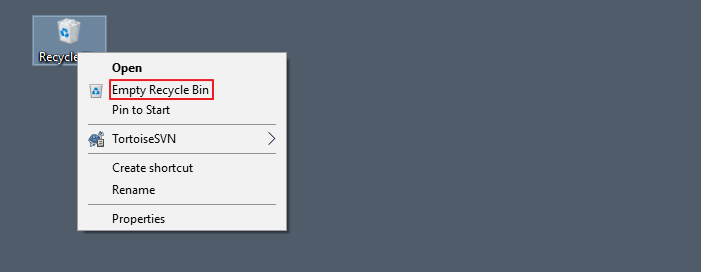
Method 2. Deal with System Junk Files (Free)
The safest and most convenient way to clean up system junk, software cache, and even useless programs all at once without worrying about damaging the system is to use junk software cleaning tools.
A professional clean-up tool, EaseUS Todo PCTrans would do you a great favor. It has developed a new feature called System Cleanup. You can regularly clean up system junk files to make your PC as good as new. Follow the details below and clean up system junk files.
Step 1. Open EaseUS Todo PCTrans on your computer. Click "More Tools". Then, click "System Cleanup" and click the "Scan" button to go on.
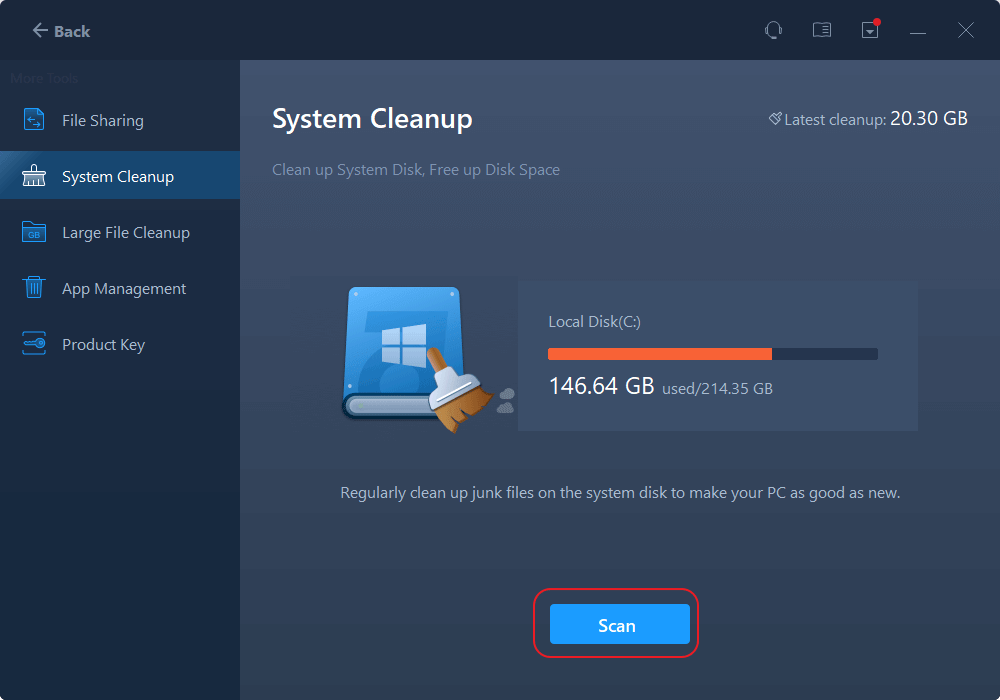
Step 2. When the scan completes, junk files will be listed. Selected the unwanted files. Be careful not to mistakenly delete files that affect the normal operation of your computer or software.
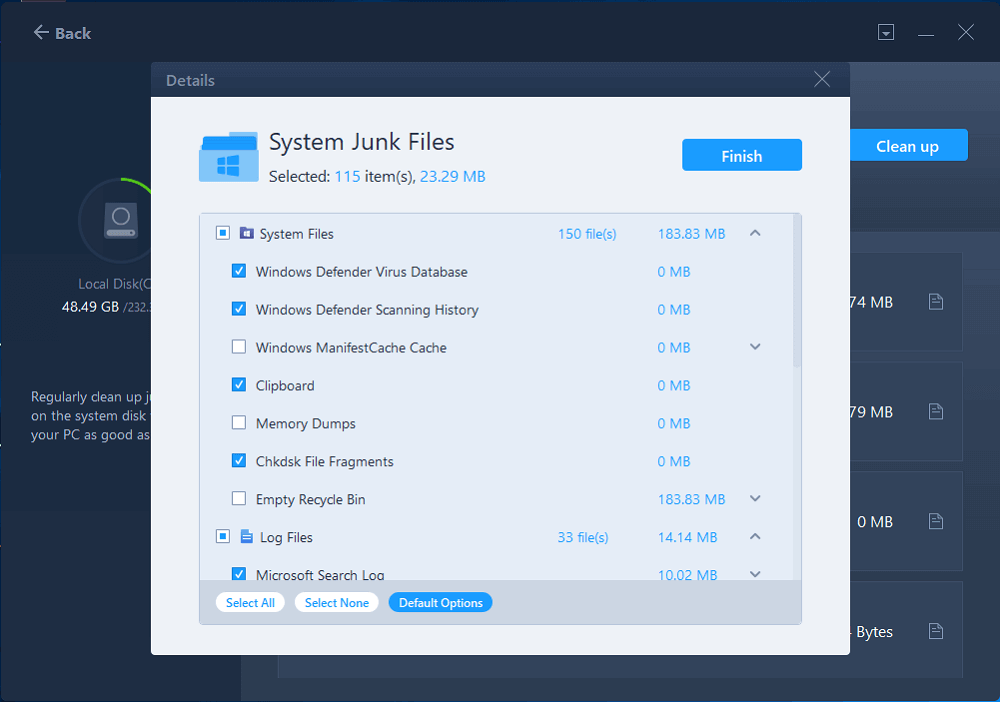
Step 3. Click the "Clean up" button and confirm the cleanup operation. You can regularly use this function to free up disk space.
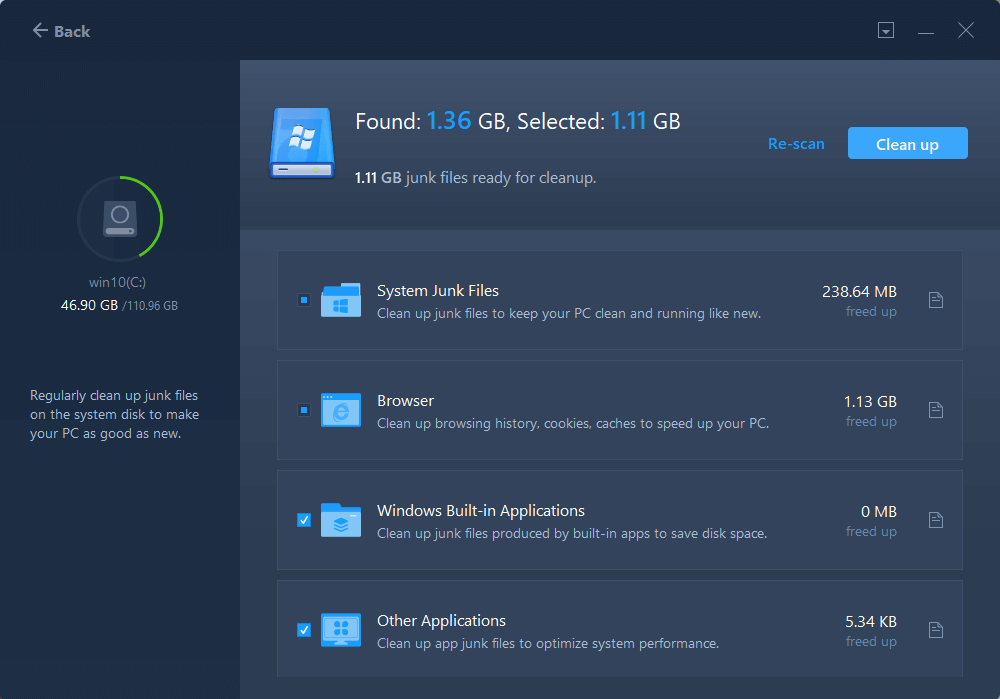
Method 3. Use Disk Cleanup to Clean Up Program Files and More
Program files, thumbnails, and log files are the files that an app installer leaves behind after installing the related app. These files are useless as they do nothing but occupy space on the hard disk drive. You may remove them without any hesitation. You can use Disk Cleanup to remove these files. Also, this Windows build-in tool can get rid of temp files, system files and more. Let's see how to clean up unwanted files:
Step 1. In the search box on the taskbar, type disk cleanup, and select "Disk Cleanup" from the list of results.
Step 2. Select the drive you want to clean up, and then select "OK".
Step 3. Select the checkbox next to the type of files you want to delete. By default, "Downloaded Program Files", "Temporary Internet Files", and "Thumbnails" are selected. Be sure to clear those check boxes if you don't want to delete those files.
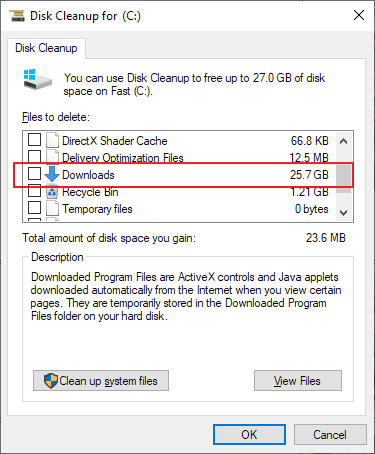
Method 4. Automatically Delete Temp Files in Windows 10
Windows always have temp files and other junk that's just taking up space on your hard drive. You can follow the settings below to automatically.
Step 1. Open "Settings". Navigate to "System > Storage".
Step 2. In the Storage sense section, turn on the "Storage sense" feature by moving the slider to on position.
Step 3. Click "Change how we free up space" links. Once again, make sure that you have turned on Storage sense feature as mentioned in the first step.
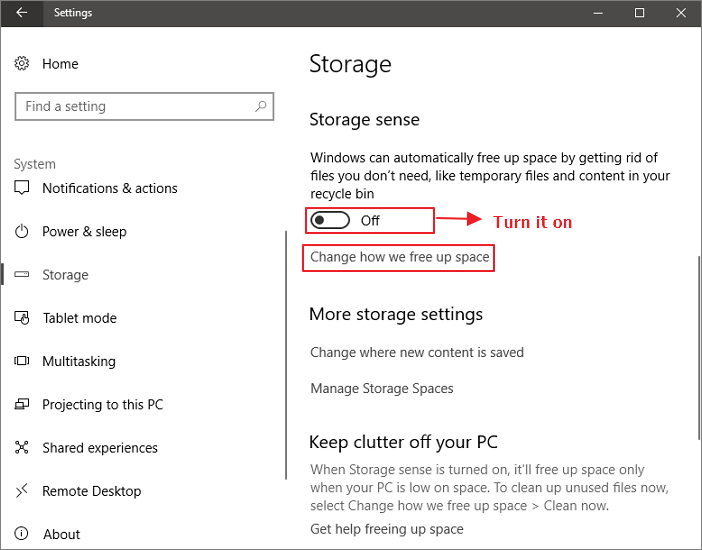
Step 4. Turn on "Delete temporary files that my apps aren't using" option and other wanted options. Then Windows 10 would delete temp files automatically.
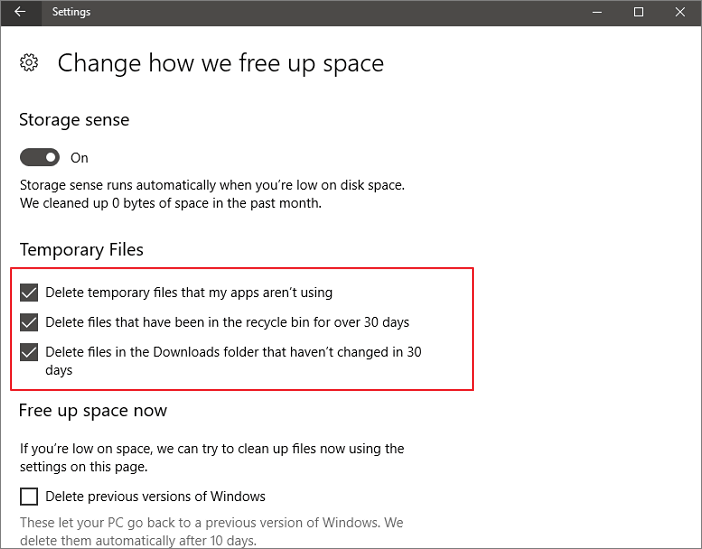
This is a handy option, Windows 10 automatically deletes all files (not just programs or any file type) that have not seen any changes over the past 30 days.
Method 5. Clean Up Large Files (Free)
If you find that the hard drive space is taken up by many large files, EaseUS Todo PCTrans is an ideal Windows 10 cleanup tool. It has a feature named Large File Cleanup that will scan and find all large files for you on your partitions. You can use it to find, locate and remove large files in Windows 10/8/7.
Step 1. Open EaseUS Todo PCTrans on your computer. Click "More Tools" on the left pane.
Then, click "Large File Cleanup" > click "Start" button to go on. (It supports move or delete large files to free up more disk space, and you can also try to move the default folders to another drive.)
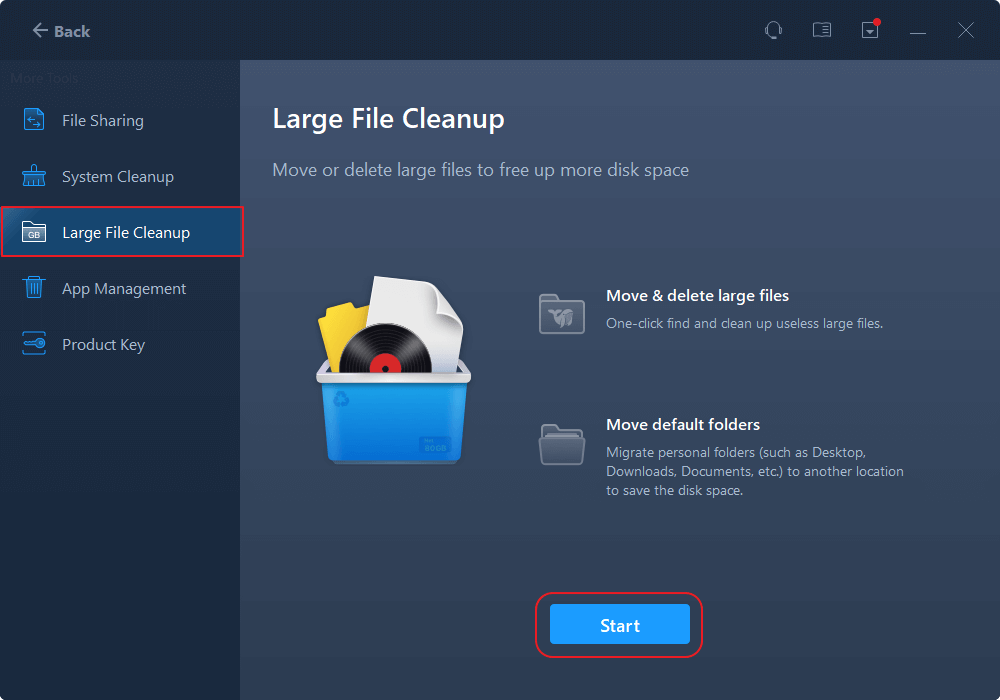
Step 2. Then choose the hard drive you want to scan.
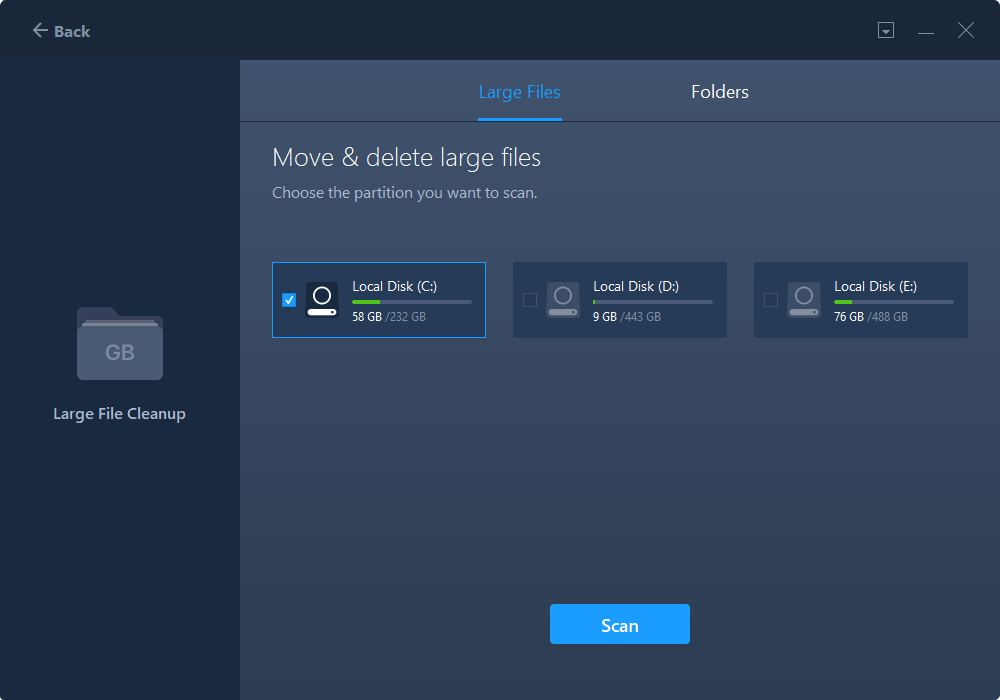
Step 3. When the scan completes, files larger than 20M will be listed. Selected the unwanted files as you need. Be careful not to mistakenly delete files that affect the normal operation of your computer or software. We also provide recommendations for deletion after the scanning is complete in "Large File Cleanup".
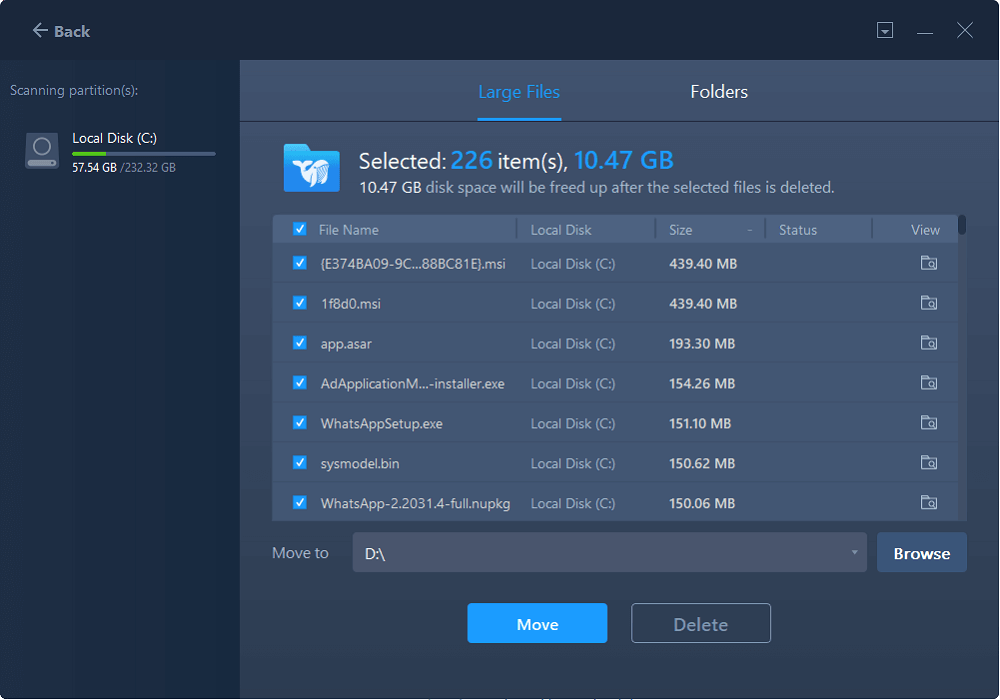
Step 4. Click the "Delete" button and confirm the delete operation again. You can regularly use this tool to remove useless large files to free up more disk space. If you have more space on other drive, choose "Move" to move large files.
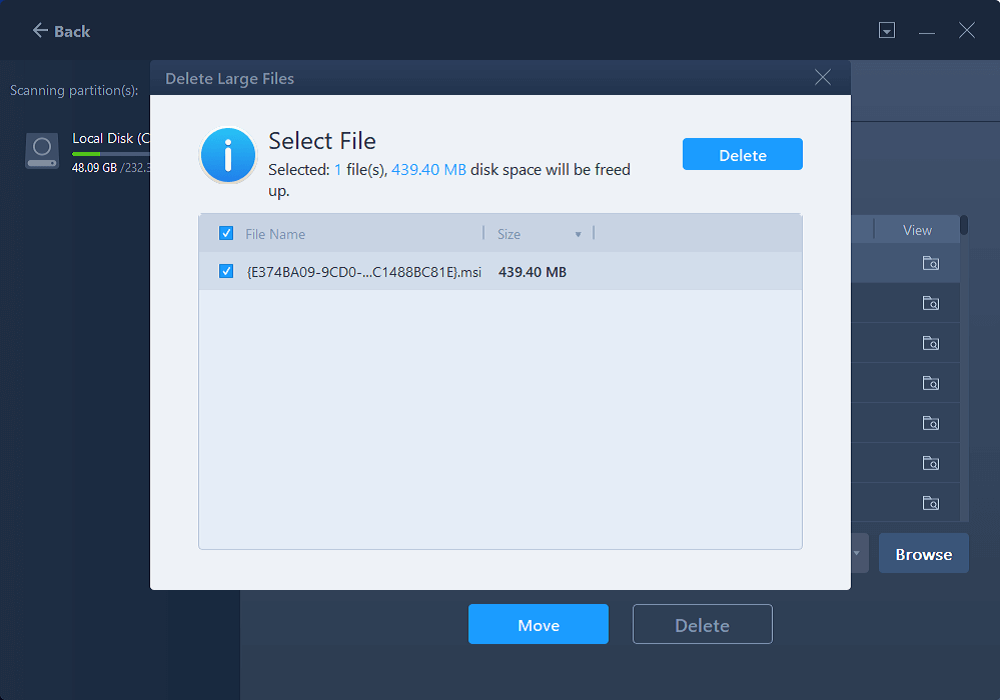
Additional Help to Deal with Large Files
In addition to getting rid of large files, you can also do the following things to deal with your large files:
1. Move large files to a cloud drive
If your hard drive won't have enough space, why not transfer files to a cloud drive like OneDrive or DropBox. The free version of OneDrive only allows you to store up to 5GB worth of files, but you can always get a subscription to lift the limit to 1000GB.
2. Transfer large files to an external hard drive
It is also a nice choice to move large files to an external hard drive. If some programs are taking up too much space, you can also transfer the apps to an external hard drive.
3. Change the game location
The Origin or Steam games could take up a lot of space. If your C drive is full, you can consider changing the game location to another drive. You don't need to redownload these games or buy them again.
More Information About Other Windows Uninstall Tools:
Windows Installer Cleanup Utility Download
Are you looking for an official way to complete Windows Installer Cleanup Utility Download? This article will provide detailed information about Windows Installer Cleanup Utility on Windows 7/10/11.
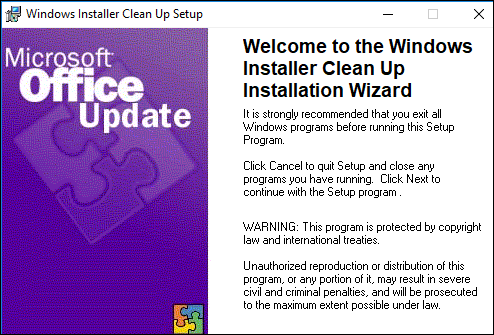
Conclusion
Using a slow PC is a frustrating experience. Hopefully, the tips provided here will make that an issue of the past. Some of these tips - such as deleting system files, or emptying the recycle bin can also expose other issues you may not have seen. Be careful, before you delete them. Feel free to leave a message if you have any questions or concerns.
About the Author
Oliver is an EaseUS professional writer who dares explore new areas. With a passion for solving tech issues with straightforward guides for common users, Oliver keeps honing his writing craft by developing in-depth solutions for disk and partition management, computer boot-up issues, file transfer, etc.
Brithny is a technology enthusiast, aiming to make readers' tech lives easy and enjoyable. She loves exploring new technologies and writing technical how-to tips. In her spare time, she loves sharing things about her game experience on Facebook or Twitter.
Reviews and Awards
-
EaseUS Todo PCTrans Free is a useful and and reliable software solution created to serve in computer migration operations, be it from one machine to another or from an earlier version of your OS to a newer one.
Read More -
EaseUS Todo PCTrans is by the folks at EaseUS who make incredible tools that let you manage your backups and recover your dead hard disks. While it is not an official tool, EaseUS has a reputation for being very good with their software and code.
Read More
-
It offers the ability to move your entire user account from your old computer, meaning everything is quickly migrated. You still get to keep your Windows installation (and the relevant drivers for your new PC), but you also get all your apps, settings, preferences, images, documents and other important data.
Read More
Related Articles
-
How to Move Ubisoft Games to Another Drive - 2 Methods
![author icon]() Oliver/2024/12/04
Oliver/2024/12/04 -
How to Repair Apps and Programs in Windows 10/11
![author icon]() Roxanne/2024/11/29
Roxanne/2024/11/29 -
Transfer Apps and Programs from PC to an External Hard Drive
![author icon]() Brithny/2024/12/04
Brithny/2024/12/04 -
Server Migration: Everything You Need to Know | 2024 Complete Guide
![author icon]() Tracy King/2024/12/04
Tracy King/2024/12/04